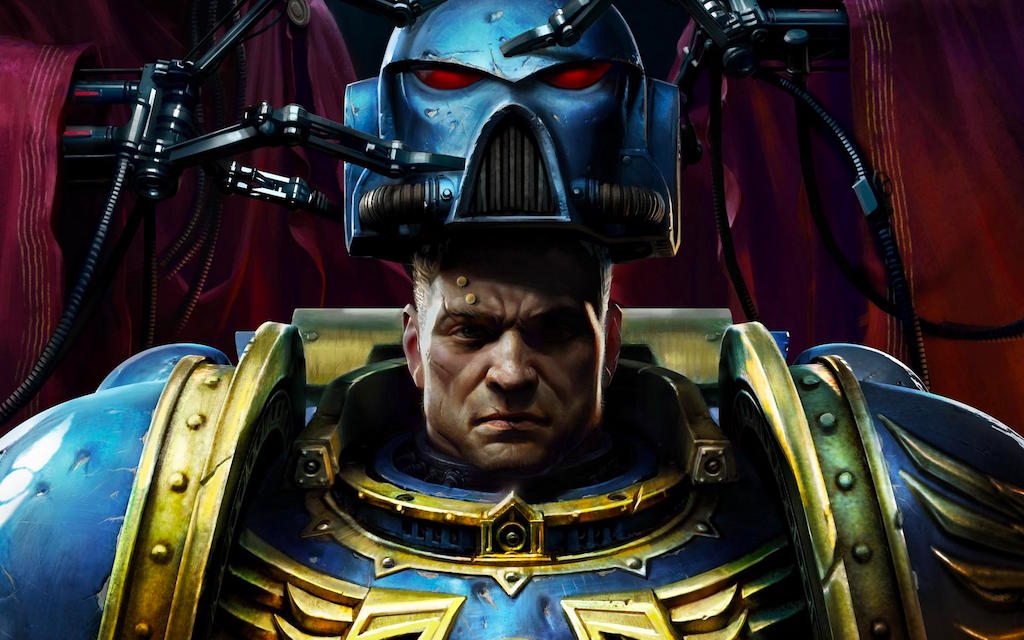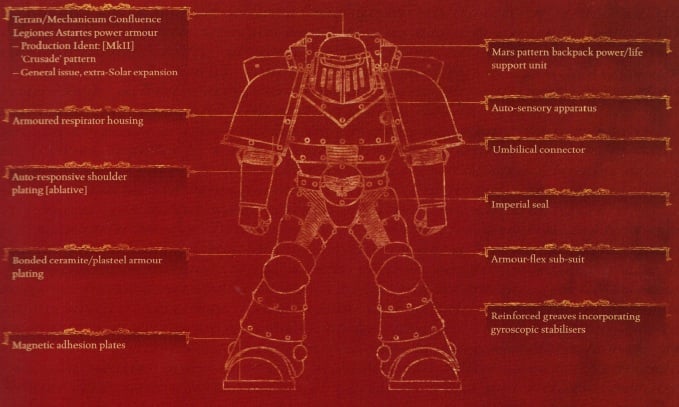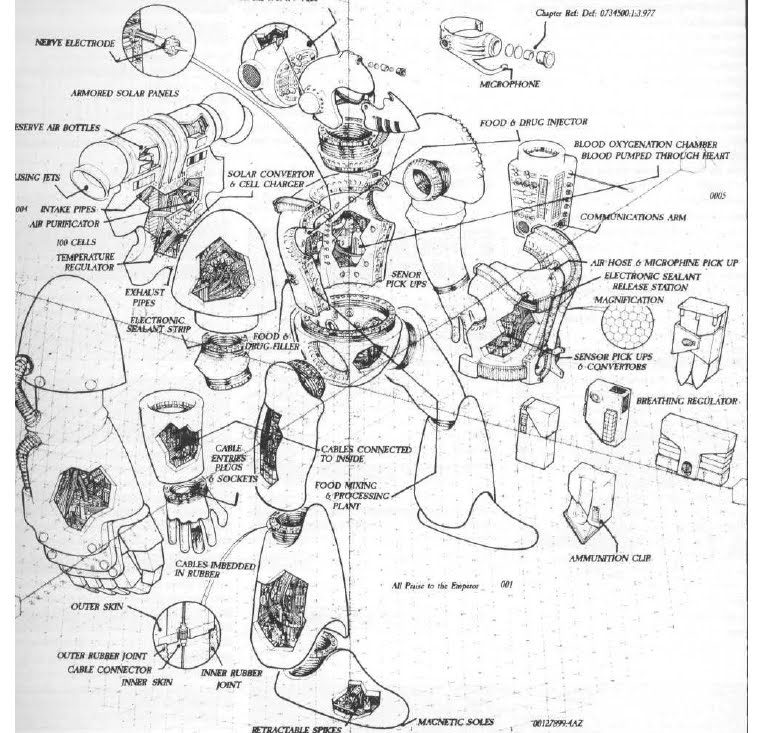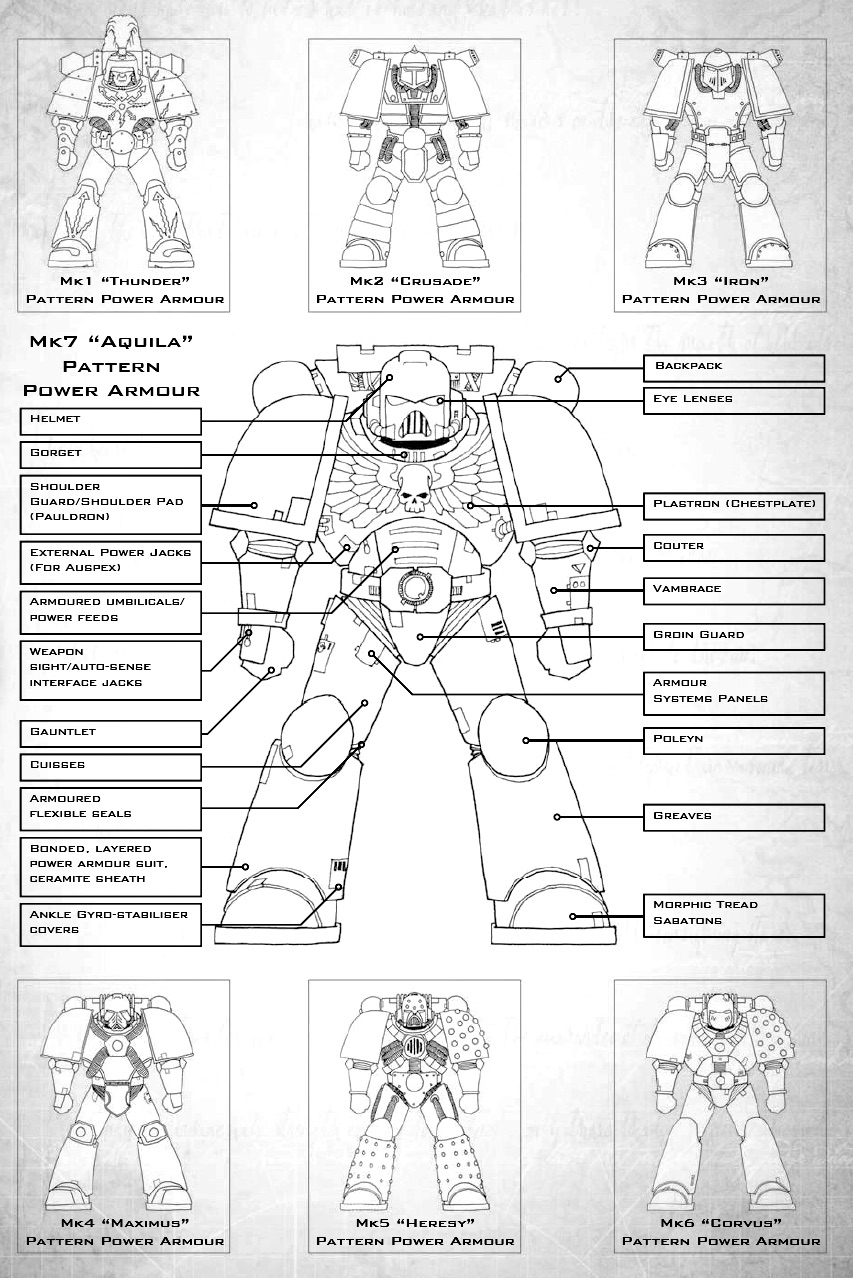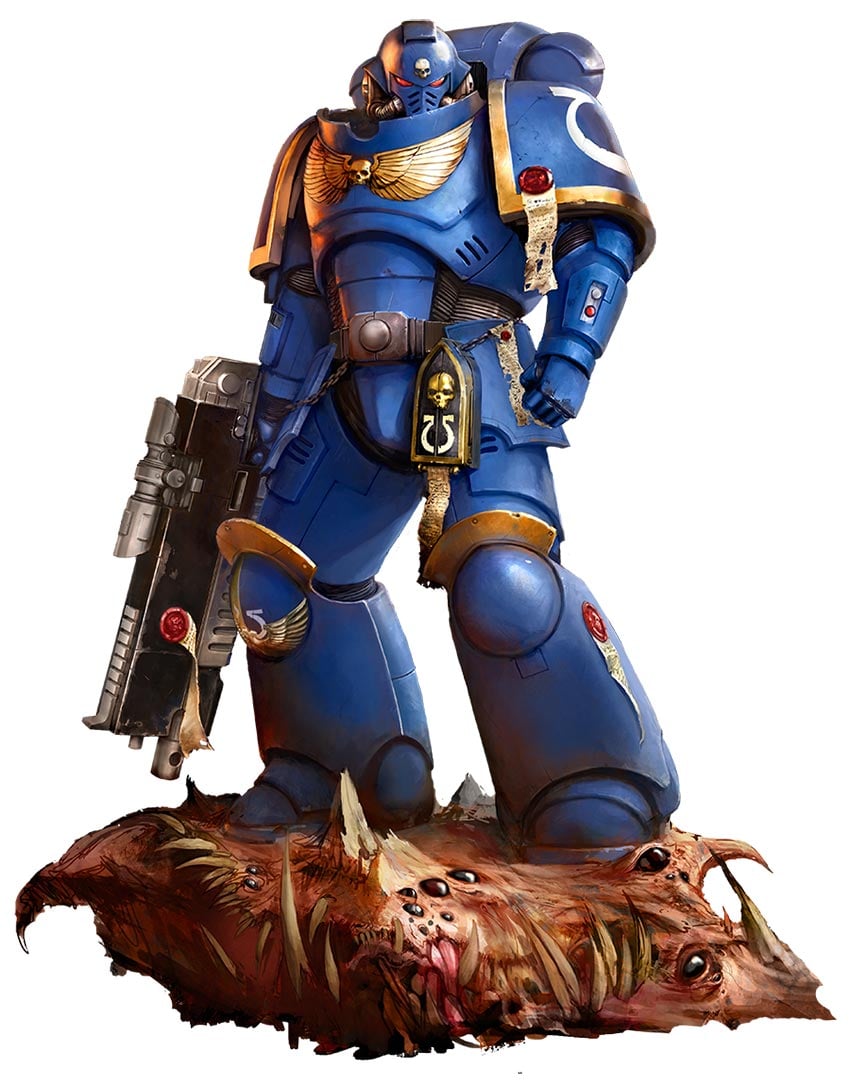40K Lore: Astartes Power Armour


Today Loremasters we delve into the powered suits of the Adeptus Astartes from the earliest to the latest designs.
Space Marine Power Armour
Space Marine Power Armour is an extraordinarily sophisticated defensive system which combines huge resistance to physical damage with a sensory array and sealed environment which protects its wearer from the ravages of the void and alien atmospheres. Integrated with the armour are networks of electro-motivated fibre bundles which mimic and augment the muscular strength of the wearer. The true genius of the design, however, lies in its close integration with the already superhuman physiology, senses and reflexes of the Space Marine within. Working in concert, armour and Astartes together become a weapon without equal.
Each suit of Space Marine Power Armour is a work of supreme artisanship, and although it may be one of many, each is a unique artifact whose spirit and history is of deep spiritual significance to both the Chapter to which it belongs and the Space Marine who wears it. It can take decades to complete just one of the new Mk VII power armour, so it is often easier to make spare part for an existing suit than it is to make a completely new one.
There are numerous different Marks of Power Armour, most of which date back in terms of design and application many thousands of years ago to the time of the Great Crusade and the Horus Heresy. Each has its own lore and genesis in place and time. Even in the 41st Millennium some intact suits from this near-mythical age survive in active service as war-relics of the Space Marines. Countless others have been produced or reacquired since, and different Chapters often have entirely different panoplies they can call upon to armour their forces. It is also far from uncommon for more recently fashioned armour to incorporate slivers or whole components from far older suits as revered connections to the past.
Space Marines go through an arduous process where they receive various implants culminating with the implantation of the Black Carapace, which allows the Marine a direct and instinctual interface with the armour, making it in effect a second skin. The advanced systems of Space Marine power armour also monitor the Marine’s biological functions, feeding the medical information to the Marine.
Components
While Space Marine Armour has evolved and changed over the Millennia, key components remain the same.[15]
- Auto-senses: Contained in the helmet, these systems include thought-activated communication arrays and audio filters, targeting reticules and range finders, tactical displays and auspex-links, and a host of other features.
- Photolenses: Protect the Space Marine from light bursts and allow him to see in the infrared and ultraviolet spectrum’s as well as enable vision in low-light conditions.
- Respirator Vox Grill: This thought-activated device amplifies a Marine’s battlecry to deafening volumes and contains a respirator to filter out toxins and draw upon an internal oxygen supply.
- Auto Responsive Shoulder Plates: Shaped to deflect and absorb incoming blows, they usually display heraldry including Chapter, Company, and Squad symbols.
- Chestpiece: Designed to protect armored power cables.
- Backpack Power Unit: This houses the primary power core for the armour, as well as reserve cells and an emergency solar collector.
- Life Signs Monitor: Regulate a suite of life support functions, including an injection system that can regulate painkillers, anti-toxins, and combat stimulants.
- Nutrient Reservoir: A self-replenishing high-energy food store that can sustain a Space Marine’s metabolism. Thus during battle, there is no need for a Space Marine to eat or drink.
- Reinforced Greaves: These incorporate gyroscopic stabilizers and power units that can magnetize the soles of the armour’s boots, allowing Space Marines to walk on metal surfaces in the void of space or zero gravity environments.
Mark I
Mark I plate was developed by the techno-barbarian factions that dominated Terra prior to the Emperor‘s ascendancy. When the Emperor began his conquest of Earth, the “Thunder Warriors“, the proto-Space Marines which formed part of his retinue, were armoured in the same way as the soldiers of the other warlords. A thunderbolt and lightning symbol was displayed on the breastplate of warriors loyal to the Emperor – this was the personal badge of the Emperor in those days, predating the Imperial Aquila which only became the symbol of the Imperium much later. The emblem gives the suit its common name – “Thunder Armour.”
Mark II
After the conquest of the main planets of the Sol system, the factories on Mars were set to work constructing a new type of armour for the Emperor’s elite Space Marines. This armoured suit is commonly referred to as “Crusade Armour,” since it was designed with the planned Great Crusade in mind, and its production led to the Thunder Armour being retroactively designated as the Mark I. It was the first fully enclosed power armour, with life-sustaining capabilities, making it suitable for combat on toxic alien planets and the depths of space.
Mark III
This model dates from the wars of the Great Crusade, waged close to the galactic core. Many of these worlds were the Squat Homeworlds, which were not pleased to find themselves the object of galactic conquest. The Squats’ independent and stubborn nature, along with the conditions of the fighting, spurred the creation of this new armour type. This armour was ideal when cover was minimal and combat was a matter of frontal assault. The most visually brutal and imposing of all the widely produced armour marks, the Iron Armour was a heavy, modified Mark II design (itself the first mass-produced Power Armour of the Crusade era). The Iron Armour’s structure has augmented frontal defence and incorporates additional ablative plates, and is intended foremost for use in boarding actions, tunnel assaults and void warfare, although it is considerably heavier and more power hungry than its contemporaries.
Mark IV
At the end of the Great Crusade the Space Marines found their armour wearing out. While some Legions chose to continue local production and maintenance, the Adeptus Mechanicus of Mars started to design a new variant for centralised issue, which was to be designated the Mark IV or Imperial Maximus suit. At the Mark IV stage of the power armour development, Space Marine armour began to take on an appearance recognisable as contemporary power armour, the main change being the abandonment of the separate abutting plates in favour of larger inflexible armour casings incorporating flexible joints. This marginally reduced mobility but was far easier to produce and maintain. Technical secrets recovered on newly conquered worlds allowed Mars to develop the more efficient armour, improving the quality of protection and reducing the suit’s weight at the same time. Improved armouring of the power cables allowed the main arm and chest supply to be safely relocated to the exterior of the armour, while the use of new material reduced the size and number of cables.
Mark V
The equipping of the legions was only partially complete when the Horus Heresy broke out. Many of the Legions that had just been fully equipped with Mark IV armour turned against the Imperium while many of the loyal Legions had been deliberately starved of access to it and and remained operating with the older Mark II and Mark III armour. Additionally, even the Legions equipped with Mark IV suits quickly found themselves low on spare parts and unable to manufacture replacement units. With war damage and mobile operations, resupply for damaged equipment was difficult or impossible. Marine artificers and Techmarines had to use old style equipment from older models to keep the legions fighting, as well as salvage from slain enemies and unorthodox innovations of their own. This ad-hoc assemblage of various armour mark segments (including new or unoffical design elements) being created by a multitude of legions resulted in an entirely new mark of armour being ‘accidentally’ created; these previously non-standard, emergency/stopgap designs were retroactively termed as the Mark V.
Mark VI
At the end of production of the Mark IV armour mark a long term research project began to replace the existing power armour. As this remained a theoretical endeavour for some time, it lead to the production of the Corvus Suit as a stopgap measure using a mixture of new and old features.
The Mark VI prototype design (which bore the provisional designation of Mk V at the time) was field-tested during the Scalland Campaign by Legionaries of the Raven Guard, whose experiences and comments resulted in improved design features in the finalised armour mark. Mark VI armour offered no better protection-levels than the Mark IV, but incorporated more efficient internal systems where power-routing and auto-sense were concerned. Power systems were given back-up redundancies with no increase in weight, while both olfactory and auditory sensors were improved. Additionally, the armour featured the best stealth capabilities of all power armour marks so far designed, as well as a new method of compartmentalising components that allowed them to be swapped out with pieces from previous marks with ease. It is the lightest variant of power armour and featured dual technology circuits that allowed the replacement of rare or sophisticated parts with common or basic alternatives.
Mark VII
Mark VII armour, also known as the “Aquila,” “Imperator” or “Eagle” armour, was developed during the Horus Heresy, and remains in use as the most common form of power armour ten thousand years later. It represents the final major development of Mark 6 armour. While the final battle for Mars was underway, the Imperium realised the planet would eventually be lost. Armour development teams were transferred to Earth to continue, incorporating their latest work into the armour type that would become Mark 7. As Mars fell to Horus, the new armour began reaching the Space Marines on Terra and Luna.
Mark 7’s main improvement is the newly designed chest plastron which covers the chest and arm cabling. The chest bears the Imperial Eagle, giving the armour its common name of Armorum Imperator, or Eagle Armour.
Mark VIII
The suit itself is a highly modified Mark 7, with additional fixed armour plates on the torso that now enclose all of the suit’s cables, which were vulnerable to weapons fire, and a new armoured collar protects the helmet’s respirator, and also addressed the vulnerability issues of the neck joint, which had been known to act as a “shell-trap”, (a round could hit the chest armour and be deflected up into the neck joint). The new collar required a new helmet design, which caused problems for backward compatibility with earlier helmet types.
Mark X
Mark X Tacticus armour is a suit that combines the most effective elements of ancestral Horus Heresy patterns of plate with more recent developments in power armour technology. These suits are currently carried into battle by Primaris Space Marines during the unfolding Indomitus Crusade.
Learn More of Powered Armour
Lexicanum
~Now the mystery is what was the fate of Mk.IX Armor.

